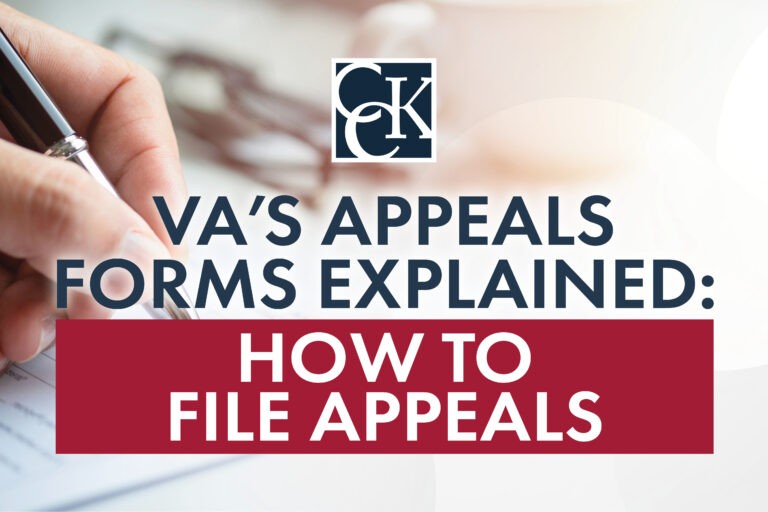VA’s New Forms Explained: How to File Appeals

Veterans can choose to appeal a Department of Veterans Affairs (VA) claims decision in one of three ways: (1) Higher-Level Review; (2) Supplemental Claim; and (3) Notice of Disagreement (i.e., an appeal to the Board of Veterans’ Appeals).
Additionally, it is important to note that while there are still active Legacy appeals following the old procedures, all new decisions are processed under the AMA system.
Which VA Appeal Form Should I Use?
To file an appeal in one of the three appeal lanes, veterans must fill out and submit one of the following forms:
- Higher-Level Review: VA Form 20-0996
- Supplemental Claim: VA Form 20-0995
- Notice of Disagreement: VA Form 10182
Each form corresponds to a review option, or lane, within the new appeals system. Claimants need to fill out these forms accurately and completely to ensure that their appeals are being processed properly.
Higher-Level Review: VA Form 20-0996
What Is a Higher-Level Review?
By opting into the Higher-Level Review lane, veterans are requesting that their VA Regional Office issue another decision based on a higher level of review. This review will be conducted by a more experienced VA employee who did not participate in making the prior decision. The higher-level reviewer will evaluate veterans’ claims de novo (i.e., a new look) and then issue another decision based on the same evidence of record on which the prior decision was made. This means that veterans are not allowed to submit additional evidence in the Higher-Level Review Lane.

To request a Higher-Level Review of a VA decision, claimants should submit VA Form 20-0996. This form allows claimants to identify the issues in VA’s decision. VA then uses this information to initiate a Higher-Level Review by an agency adjudicator.
How to Fill Out VA Form 20-0996: Higher-Level Review
The Higher-Level Review form contains the following sections:
Section I and II: Claimant’s Identifying Information: These sections require claimants to fill out the following information: full name; Social Security number; date of birth; current mailing address; telephone number; and benefit type (e.g., compensation, pension/survivors benefits, etc.). Veterans should fill out Section I, and claimants who are not veterans can fill out Section II.
Section III: Benefit Type: In this section, claimants must select the benefit type for which they are requesting a review.
Section IV: Optional Informal Conference: The claimant or their representative can request an optional informal conference over the phone with the higher-level reviewer to point out the issues and errors in the prior decision.
Section V: Opt-in from SOC/SSOC: If following a Statement of the Case (SOC) or Supplemental Statement of the Case (SSOC), then claimants must indicate if they are electing to participate in the modernized review system by marking the checkbox.
Section VI: Issues for Higher-Level Review: In this section, claimants must indicate each issue decided by VA for which they are requesting a Higher-Level Review, along with the date of VA’s decision notice in which it was originally denied or partially granted.
Section VII and VIII: Certification and Signature: Section VII is used to finalize the claimant’s request for review. Section VIII is for the authorized representative’s signature, if applicable.
Supplemental Claim: VA Form 20-0995
What Is a Supplemental Claim?
In the Supplemental Claim lane, claimants are electing to have someone at the same level as the original reviewer look over their claim. However, they now have the option to add new and relevant evidence. VA is required to readjudicate claims if new and relevant evidence is presented.

The Supplemental Claim lane is the only appeal lane in which VA has a duty to assist veterans in gathering evidence to support their claims. VA does not have a duty to assist during the Higher-Level Review process or in appeals to the Board.
Claimants must submit VA Form 20-0995 to initiate a supplemental claim for VA disability compensation. Veterans must also submit or inform VA of new and relevant evidence to open a supplemental claim. From there, veterans have up until the time VA issues a supplemental claim decision to submit any additional evidence.
How to Fill Out VA Form 20-0995: Supplemental Claim
VA has indicated that VA Form 20-0995 is necessary to identify the issues that a claimant is dissatisfied with and then determine the claimant’s eligibility to apply for a supplemental claim. The supplemental claim form is broken up into the following sections:
Part I: Claimant’s Identifying Information: This section requires claimants to fill out the following information: full name; Social Security number; date of birth; current mailing address; telephone number; and benefit type (e.g., compensation, pension/survivors benefits, etc.).
Part II: Issue(s) for Supplemental Claim: In this section, claimants must list each issue that they would like VA to readjudicate as part of the supplemental claim. Each specific issue must be included along with the date of the VA decision notice in which it was originally denied or partially granted. This section also affirms that by submitting this form following a Statement of the Case (SOC) or Supplemental Statement of the Case (SSOC), claimants are withdrawing all eligible appeal issues listed on the form from the legacy system.
Part III: New and Relevant Evidence: To complete a supplemental claim, claimants must submit new and relevant evidence or tell VA about new and relevant evidence that they can assist in gathering. If claimants want VA to retrieve federal records, such as treatment records from VA medical centers, then claimants must list the name and location of the facility and the dates of the records.
Part V: Certification and signature: This section is mandatory, and completion is required for VA to process the supplemental claim. By signing, veterans are indicating that the information in the supplemental claim is true and correct.
Notice of Disagreement (Board Appeal): VA Form VA10182
What Is a Notice of Disagreement (Board Appeal)?
A Notice of Disagreement (NOD) is a formal statement letting the Department of Veterans Affairs (VA) know that you disagree with its decision on your disability claim. Importantly, all appeals to the Board must be submitted directly to the Board and will no longer be accepted by any Regional Office.

To be accepted by the Board, a complete Notice of Disagreement must identify the specific determination with which the claimant disagrees and must indicate which docket they choose:
- Direct review docket. In this docket, the Board will look only at the evidence that was in the veteran’s file when the appealed decision was issued.
- Hearing docket. In this docket, veterans can have a hearing in front of a Veterans Law Judge. Veterans can have a videoconference hearing or a hearing at the Board in Washington, D.C. Additional evidence can be submitted up to 90 days from when the hearing is held.
- Evidence docket. In this docket, veterans can submit additional evidence to the Board along with their Notice of Disagreement. They can also submit evidence within 90 days following submission of the Notice of Disagreement.
To learn more about each Board docket and what follows a Board decision, check out this CCK blog.
How to Fill Out VA Form VA10182: Notice of Disagreement
Claimants must submit a Notice of Disagreement using VA Form VA10182 to appeal one or more previously decided issues to the Board of Veterans’ Appeals (Board). VA Form VA10182 is organized as follows:
Part I: Personal Information: Like the Supplemental Claim Application and the Application for Higher-Level Review, the Notice of Disagreement requires claimants to fill out the following information: full name; Social Security number; date of birth; current mailing address; and telephone number.
Part II: Board Review Option: In this section, claimants must select which Board docket they want their appeal processed under: (1) direct review by a Veterans Law Judge; (2) evidence submission reviewed by a Veterans Law Judge; or (3) hearing with a Veterans Law Judge. Claimants are only permitted to check one of the review boxes.
Part III: Specific Issue(s) to be Appealed to a Veterans Law Judge at the Board: Here claimants must list each issue decided by VA that they want to appeal to the Board. They must also include the date(s) of the unfavorable VA decision notices.
Part IV: Certification and Signature: Claimants must sign and date the form to finalize their appeal to the Board.
Was Your Appeal Denied by VA?
If you submitted an appeal to VA and they again denied your claim, Chisholm Chisholm & Kilpatrick LTD may be able to help. Our team has decades of collective experience representing veterans before VA, the Board, and the Court of Appeals for Veterans Claims (CAVC). Reach out to CCK today to schedule a free case evaluation or call us at (800) 544-9144 today to speak with a member of our team.
About the Author
Share this Post
